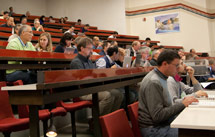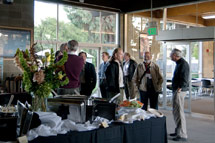
Handy Links
SLAC News Center
SLAC Today
- Subscribe
- Archives: Feb 2006-May 20, 2011
- Archives: May 23, 2011 and later
- Submit Feedback or Story Ideas
- About SLAC Today
SLAC News
Lab News
- Interactions
- Lightsources.org
- ILC NewsLine
- Int'l Science Grid This Week
- Fermilab Today
- Berkeley Lab News
- @brookhaven TODAY
- DOE Pulse
- CERN Courier
- DESY inForm
- US / LHC
SLAC Links
- Emergency
- Safety
- Policy Repository
- Site Entry Form

- Site Maps
- M & O Review
- Computing Status & Calendar
- SLAC Colloquium
- SLACspeak
- SLACspace
- SLAC Logo
- Café Menu
- Flea Market
- Web E-mail
- Marguerite Shuttle
- Discount Commuter Passes
-
Award Reporting Form
- SPIRES
- SciDoc
- Activity Groups
- Library
Stanford
Around the Bay
Tenth SuperB Workshop Explores Potential U.S. Roles
The SuperB Project Workshop and Proto-Collaboration Meeting X wrapped up on Friday following four days of presentations and break-out sessions at SLAC. The tenth SuperB workshop brought together about one hundred physicists focused on preparing a technical design for the proposed positron–electron collider.
"This is a time to get the international team together and progress further towards a technical design for SuperB," said University of Pisa and INFN physicist Francesco Forti. The SuperB project is led by Italy's National Institute for Nuclear Physics, or INFN, with collaboration from physicists around the world, including many from SLAC. The INFN has presented the SuperB Project's Conceptual Design Report to the Italian government for review. In the meantime, the members met at SLAC to discuss possible sites, computing needs, and detector and machine design.
The proposed B-meson factory would use highly focused positron and electron beams, 100 times brighter than those used in SLAC's PEP-II collider, for a higher-than-ever rate of interactions between the particles. "With the higher SuperB luminosity, you can acquire events 100 times faster and see the physics details 100 times sharper than with BaBar," said SuperB mastermind Pantaleo Raimondi who formerly worked for SLAC and now works at Frascati National Laboratory in Italy.
SLAC Director of Particle Physics and Astrophysics David MacFarlane opened the workshop with a presentation focused on the U.S. involvement with SuperB. A recent request from the Department of Energy asked SLAC to assess options for involvement in SuperB. "The request shows recognition of the exciting science opportunity and reflects a desire to broaden the base of high-energy physics at a national level," MacFarlane said. "In addition, it reflects an interest by SLAC in taking the lead role for the U.S. community in managing the U.S. high-energy physics involvement in the SuperB project, should Italy launch the project in the coming months."
Many SLAC physicists will be collaborating on the SuperB project design. "There is a large SLAC contingent because of the unique expertise developed over the years through BaBar and PEP-II," Forti said. In preparing the assessment for the DOE, John Seeman and Michael Sullivan bring substantial accelerator design and operational experience from their leadership roles in the SLAC PEP-II collider and will head up a working group on possible U.S. machine contributions. BaBar Program Manager Blair Ratcliff and Hassan Jawahery of the University of Maryland are jointly overseeing a working group for possible U.S. engagement in the detector design and construction.
"SLAC is one of few labs world-wide that have experience in designing, building and operating high luminosity electron-positron colliders," said SLAC Professor and Emeritus Director of Research David Leith, captain of the SLAC SuperB detector group. "Our involvement is very important to the success of the project."
In addition to new construction, many existing components of PEP-II and the BaBar detector, along with items from other labs worldwide, could be given a new life with SuperB. Reusing parts such as the PEP-II magnets and radio frequency components could substantially reduce construction costs of the proposed factory. Recycling these items would keep the world a little greener, too; SLAC would otherwise need to dispose of or store these large items.
Meanwhile, steps to secure funding and launch the SuperB project are continuing. "SuperB is proposed as a European supported project," said project manager Marcello Giorgi, "and in its September 2009 meeting, the CERN Council, acting as a European Strategy Group, has recognized that SuperB is in agreement with the European Strategy for Particle Physics."
As the meeting drew to a close Jawahery commented, "The workshop has been very productive, both in advancing detailed planning for the SuperB project and in launching the process of assessment of potential U.S. roles."
—Lauren Knoche
SLAC Today, October 12, 2009

